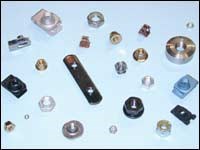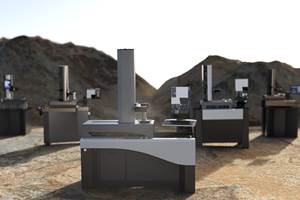In-Process Thread Inspection
A supplier that cannot guarantee thread quality can be hit with thousands of dollars in penalties and risks a strained relationship.
Because of the high cost of nonconforming parts, product companies are increasingly requiring their suppliers to provide 100 percent inspection of internally threaded parts. Customers want to verify not only thread presence but also thread quality. Incompletely threaded holes or obstructed threads can cause significant downtime with automated assembly equipment. A supplier that cannot guarantee thread quality can be hit with thousands of dollars in penalties and risks a strained relationship.
Some things are easier said than done, especially in high production. While external threads are accessible to a number of inspection techniques, internal threads are difficult to check rapidly.
A couple of advances in the field of motion control have made high speed mechanical verification of internal threaded holes a preferred alternative for some manufacturers. The experience of Baltimore, Maryland-based custom machine builder New Vista Corporation has shown the relative virtues of mechanical thread checking. New Vista Corporation recently built a unit for a leading panel nut manufacturer for high speed thread checking of panel nuts. The unit is integrated into an existing stamping/forming machine line and takes the place of eddy current units that proved unreliable. Including index, the six-spindle unit processes six nuts every 0.85 seconds or 25,400 nuts every hour.
Because the index is 0.35 seconds, the six mechanical gages must fully probe and exit the part within a half-second. “Ten years ago, this wouldn’t have been possible to do reliably,” says Jim Brun, vice president of engineering at New Vista.
Two motion control advances have made this very short cycle possible: mid-motion servomoto drive command changes, and the shortening of program logic controller can times (or time to process signals) from milliseconds to microseconds.
Mechanically, each spindle is designed for high production work. A high response servomotor drives a special coated thread gage probe, which is essentially a “go” gage. In between is a compression compensating mechanism, which prevents damage to both the drive and nut strip in the event that the part is not threaded.
Also in the drive is a torque limiter mechanism that permits the gage to stall in incomplete or damaged threads or spin at the entrance of missing threads. Either event causes the spindle to fall short of a limit, signaling a reject. (A “probe presence” sensor ensures that the gage probe is in place.) The drive in this device reverses at full torque to ensure that the gage exits the part, even if it jams in a damaged thread.
Mechanical verification has a few benefits. For one thing, it simulates how the threaded hole is actually going to be used. If the gage probe passes through the part, then the assembly line screw is sure to thread properly. In addition, this type of mechanical system is very robust; if the hole is out of position or has a broken tap in it, the compression compensating mechanism and torque limiter mechanism will protect the unit.
The downside of mechanical testing is the wear on the unit. Mr. Brun recommends that a manufacturer keep a spare spindle and gage probe in stock. A probe should be replaced every 1.5 million cycles, he says.
Related Content
Automated Inspection Transforms Medical Manufacturer’s Quality Control
Manual steps for part inspection have been eliminated with a new CMM process using more advanced software and strategies such as using a combined scanning/touch-trigger probe.
Read MoreThe Value of CMM Controller Retrofits
In this case, new controllers for two coordinate measuring machines — one 26 years old — with new programming software offers the possibility to enable multisensor inspection of critical, turned aerospace components.
Read MorePMTS 2023 Product Preview: Measurement
Learn about some of the latest measurement solutions that will be on display at PMTS 2023.
Read MorePrecision Machining Technology Review: December 2023
Production Machining’s December 2023 technology showcase includes some of the latest technology from Sandvik Coromant, Nikon Metrology, The L.S. Starrett Co., Walter USA, Kennametal and SolidCAM.
Read MoreRead Next
5 Aspects of PMTS I Appreciate
The three-day edition of the 2025 Precision Machining Technology Show kicks off at the start of April. I’ll be there, and here are some reasons why.
Read MoreDo You Have Single Points of Failure?
Plans need to be in place before a catastrophic event occurs.
Read MoreA Tooling Workshop Worth a Visit
Marubeni Citizen-Cincom’s tooling and accessory workshop offers a chance to learn more about ancillary devices that can boost machining efficiency and capability.
Read More









.jpg;maxWidth=300;quality=90)













